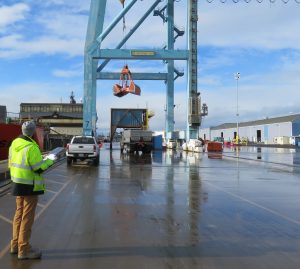Smoke School is cool
 Have you ever watched a gymnastics tournament where the athletes rub their hands full of chalk, then clap them together, creating a cloud of white dust? Without any tools besides your eyes, would you be able to tell the opacity of that cloud? Port of Vancouver Environmental Specialist Phillip Martello can, and he’s putting his unique qualification to good use supporting air quality at the Port of Vancouver USA.
Have you ever watched a gymnastics tournament where the athletes rub their hands full of chalk, then clap them together, creating a cloud of white dust? Without any tools besides your eyes, would you be able to tell the opacity of that cloud? Port of Vancouver Environmental Specialist Phillip Martello can, and he’s putting his unique qualification to good use supporting air quality at the Port of Vancouver USA.
Opacity is the ability to see a background through a cloud of particulates. The port has an air permit with the Southwest Clean Air Agency (SWCAA) that regulates emission requirements for bulk commodity transfers based on stringent opacity criteria. That means our bulk commodities like fertilizer must be closely monitored to ensure they’re not discharging too many particulates when being transferred.
Martello is certified to observe these transfers to determine whether they meet SWCAA requirements. To receive certification, Phil and some of our tenants participate in “Smoke School,” a bi-annual training that uses trailer-mounted wood stoves to simulate black and white smoke plumes. Trainees are required to record their visual opacity observations—an impressive ability and one that helps activities at the port in many ways.
Having a certified professional on staff to observe, test and certify results allows us to maintain many of the efficiencies we have built into the cargo-handling process while adhering to high environmental standards. This, in turn, saves time in hiring and scheduling outside consultants to perform the work and allows for a consistent watchful eye over all bulk handling emissions at the port.
